Conclusion: Final Thoughts on Using This Pocket Guide
The Scenario:
Overview
Jasmine Doe is the CEO of a mid-sized company that manufactures state-of-the-art components for the video editing industry. The company has had a Six Sigma program for just over a year, and the team that worked on the New Product to Market project was wildly successful, even getting some press for their efforts.
With the significant reduction in the time it took to develop the last new product, it became obvious that the new product marketing cycle couldn’t keep up. There is a lot of energy in the company to launch a new Six Sigma team to improve the marketing process.
Even with less than adequate marketing, the new product is selling better than expected. Jasmine has been doing a great deal of personal promotion with customers. Discus-sions keep getting sidetracked, however, by complaints about the company’s billing system. Invoices arrive late, are hard to understand, and have errors, and no one at the home office seems to have any answers when the customers complain. Jasmine has decided to launch a Six Sigma team to improve the billing process before or maybe at the same time as the marketing improvement process. She’s not really sure the billing project is worth the effort of a Six Sigma team, but she’s had it with listening to complaints.
Jasmine called a meeting with Art Lee, the manager of the billing department, and William Boyd, VP of MIS. Art agreed that the project would be a good idea, mainly because it would make the clerks in his department happy to be on a Six Sigma project. He was, however, a bit annoyed that it took so long to get Six Sigma resources for his department. He even went so far as to imply that Jasmine helped cause the billing problem by withholding resources in spite of his repeated requests. Things got a little tense at this point of the meeting.
Bill Boyd said he thought the marketing project was a lot more important to the company. (Jasmine secretly agrees, as this is where her interests and skills lie, but part of her recognizes the need to deal with the invoicing issues.) And he felt a bit defensive, since he helped create the original billing process. But Bill reluctantly agreed to let the majority rule, as long as nobody tried to tell him how to run MIS (like that Black Belt working on the new product development cycle did last year).
As a result of the discussion at the meeting, Jasmine has assigned a Black Belt, Thomas, to the Billing Improvement project. Following are sample plans for getting buy-in on a Six Sigma project to improve billing processes. We’ve included a plan for Thomas and the project team to use to:
-
Get buy-in from senior management (J. Doe, CEO)
-
Get buy-in from middle management (W. Boyd, MIS VP)
-
Get buy-in from line workers (Billing Department clerks)
Sample Project Stakeholder Identification Worksheet with Map

Sample Senior Management Stakeholder Analysis
Tool 17-1.

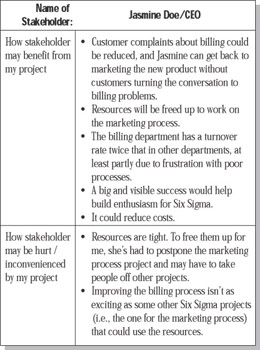
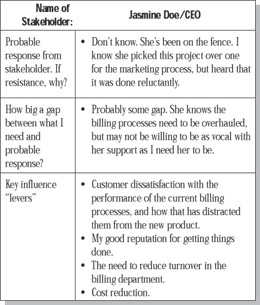

Sample Senior Management Stakeholder Plan
Tool 17-2.


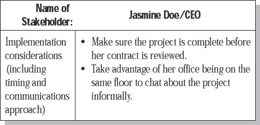
Sample Middle Management Stakeholder Analysis
Tool 17-3.

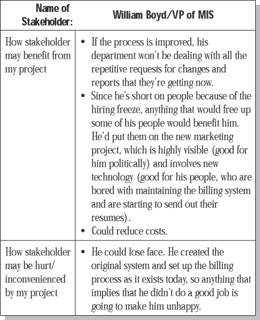
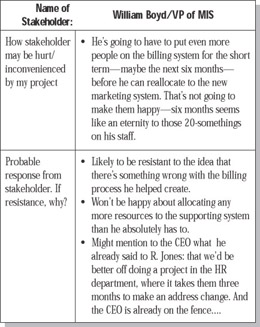

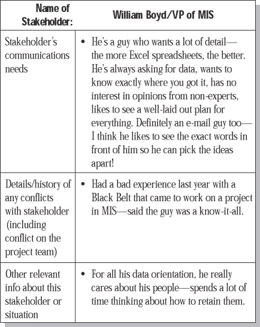
Sample Middle Management Stakeholder Plan
Tool 17-4.

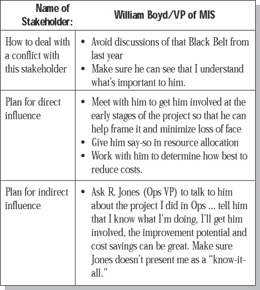

Sample Line Worker Stakeholder Analysis
Tool 17-5.

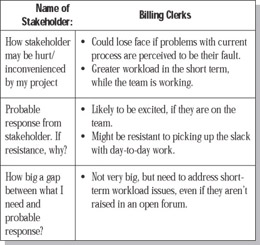
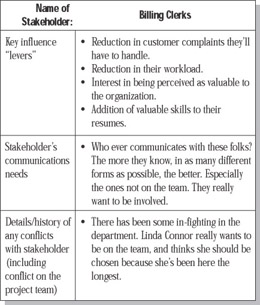
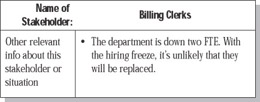
Sample Line Worker Stakeholder Plan
Tool 17-6.

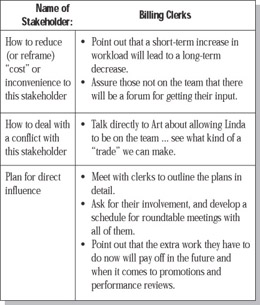

EAN: 2147483647
Pages: 65